Papers by Philip de Witt Hamer

Acta Neurochirurgica, 2010
Background (1) To determine the optimal administration site and dose of indocyanine green (ICG) f... more Background (1) To determine the optimal administration site and dose of indocyanine green (ICG) for blood volume measurement using pulse spectrophotometry, (2) to assess the variation in repeated blood volume measurements for patients after subarachnoid hemorrhage and (3) to evaluate the safety and efficacy of this technique in patients who were treated for an intracranial aneurysm. Methods Four repeated measurements of blood volume (BV) were performed in random order of bolus dose (10 mg or 25 mg ICG) and venous administration site (peripheral or central) in eight patients admitted for treatment of an intracranial aneurysm. Another five patients with subarachnoid hemorrhage underwent three repeated BV measurements with 25 mg ICG at the same administration site to assess the coefficient of variation. Findings The mean ± SD in BV was 4.38 ± 0.88 l (n = 25) and 4.69 ± 1.11 l (n = 26) for 10 mg and 25 mg ICG, respectively. The mean ± SD in BV was 4.59 ± 1.15 l (n = 26) and 4.48 ± 0.86 l (n = 25) for central and peripheral administration, respectively. No significant difference was found. The coefficient of variance of BV measurement with 25 mg of ICG was 7.5% (95% CI: 3–12%). Conclusions There is no significant difference between intravenous administration of either 10 or 25 mg ICG, and this can be injected through either a peripheral or central venous catheter. The 7.5% coefficient of variation in BV measurements determines the detectable differences using ICG pulse spectrophotometry.
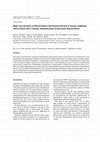
Journal of Neuro-oncology, 2001
The value of chemotherapy in patients with malignant astrocytoma remains controversial. In our la... more The value of chemotherapy in patients with malignant astrocytoma remains controversial. In our laboratories in vitro experiments with organotypic spheroid cultures showed superior effectiveness of anthracyclines. Systemic administration did not provide in therapeutic concentrations so far. Because recent studies on Daunorubicin in liposomes in the treatment of Kaposi sarcoma have shown effectiveness with diminished systemic toxicity, we administered intravenously a single dose of Daunorubicin in liposomes in eight patients at different intervals prior to surgery (12–50 h). In samples taken from tumor, tumor-edge and where possible from adjacent brain, the levels of Daunorubicin and its active metabolite Daunorubicinol were assessed with high performance liquid chromatography. Here we report that high concentrations of Daunorubicin and Daunorubicinol were found in malignant gliomas after systemic administration of liposomal Daunorubicin.
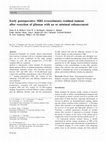
European Radiology, 2011
Background Standards for residual tumour measurement after resection of gliomas with no or minima... more Background Standards for residual tumour measurement after resection of gliomas with no or minimal enhancement have not yet been established. In this study residual volumes on early and late postoperative T2-/FLAIR-weighted MRI are compared. Methods A retrospective cohort included 58 consecutive glioma patients with no or minimal preoperative gadolinium enhancement. Inclusion criteria were first-time resection between 2007 and 2009 with a T2-/FLAIR-based target volume and availability of preoperative, early (<48 h) and late (1–7 months) postoperative MRI. The volumes of non-enhancing T2/FLAIR tissue and diffusion restriction areas were measured. Results Residual tumour volumes were 22% smaller on late postoperative compared with early postoperative T2-weighted MRI and 49% smaller for FLAIR-weighted imaging. Postoperative restricted diffusion volume correlated with the difference between early and late postoperative FLAIR volumes and with the difference between T2 and FLAIR volumes on early postoperative MRI. Conclusion We observed a systematic and substantial overestimation of residual non-enhancing volume on MRI within 48 h of resection compared with months postoperatively, in particular for FLAIR imaging. Resection-induced ischaemia contributes to this overestimation, as may other operative effects. This indicates that early postoperative MRI is less reliable to determine the extent of non-enhancing residual glioma and restricted diffusion volumes are imperative.
Journal of Histochemistry & Cytochemistry, 2005
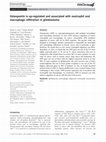
Immunology, 2010
Osteopontin (OPN) is a glycophosphoprotein with multiple intracellular and extracellular function... more Osteopontin (OPN) is a glycophosphoprotein with multiple intracellular and extracellular functions. In vitro, OPN enhances migration of mouse neutrophils and macrophages. In cancer, extracellular OPN facilitates migration of cancer cells via its RGD sequence. The present study was designed to investigate whether osteopontin is responsible for neutrophil and macrophage infiltration in human cancer and in particular in glioblastoma. We found that in vitro mouse neutrophil migration was RGD-dependent. In silico, we found that the OPN gene was one of the 5% most highly expressed genes in 20 out of 35 cancer microarray data sets in comparison with normal tissue in at least 30% of cancer patients. In some types of cancer, such as ovarian cancer, lung cancer and melanoma, the OPN gene was one of those with the highest expression levels in at least 90% of cancer patients. In glioblastoma, the most invasive type of brain tumours/glioma, but not in lower grades of glioma it was one of the 5% highest expressed genes in 90% of patients. In situ, we found increased protein levels of OPN in human glioblastoma versus normal human brain confirming in silico results. OPN protein expression was co-localized with neutrophils and macrophages. In conclusion, OPN in tumours not only induces migration of cancer cells but also of leucocytes.

Statistical Applications in Genetics and Molecular Biology, 2008
Multiple changes at the DNA level are at the basis of complex diseases. Identifying the genetic n... more Multiple changes at the DNA level are at the basis of complex diseases. Identifying the genetic networks that are influenced by these changes might help in understanding the development of these diseases. Canonical correlation analysis is used to associate gene expressions with DNAmarkers and thus reveals sets of co-expressed and co-regulated genes and their associating DNAmarkers. However, when the number of variables gets high, e.g. in the case of microarray studies, interpretation of these results can be difficult. By adapting the elastic net to canonical correlation analysis the number of variables reduces, and interpretation becomes easier, moreover, due to the grouping effect of the elastic net co-regulated and co-expressed genes cluster. Additionally, our adaptation works well in situations where the number of variables exceeds by far the number of subjects.
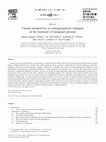
Brain Research Reviews, 2004
Progressive tumor growth depends on angiogenesis to sustain metabolic needs of tumor cells, thus ... more Progressive tumor growth depends on angiogenesis to sustain metabolic needs of tumor cells, thus providing a potential target for cancer therapy. Malignant gliomas have retained their dismal prognosis despite aggressive multimodal conventional therapeutic approaches, illustrating the need for novel therapeutic strategies. Gliomas are a suitable tumor type for probing angiogenesis inhibition as their proliferation is characterized by a prominent proliferative vascular component. In the present review, we discuss the current status and future directions of angiogenesis inhibition in gliomas. We focus on recently developed approaches inducing an antiangiogenic response such as targeted gene delivery, protein tyrosine kinase inhibitors and encapsulated producer cells. Although several of these modalities have shown promising results on their own, the true potential of these novel approaches lies in their combined use with radiotherapy or 'metronomically scheduled' chemotherapy. A combined approach potentially counteracts the selective pressure on hypoxia-resistant malignant tumor cells, circumvents endothelial resistance induced by local cytoprotective responses and enhances the delivery of cytotoxic agents by normalizing vascular physiology. Surrogate markers of angiogenesis currently under study may provide accurate assessment of response in individual patients. Future research on endothelial markers expressed on tumor-associated vasculature as well as endothelial responses to cytotoxic treatment will provide new avenues for molecularly targeted therapy in malignant gliomas. D

Oncogene, 2008
Screening of therapeutics relies on representative cancer models. The representation of human gli... more Screening of therapeutics relies on representative cancer models. The representation of human glioblastoma by in vitro cell culture models is questionable. We obtained genomic profiles by array comparative genomic hybridization of both short-and long-term primary cell and spheroid cultures, derived from seven glioblastomas and one anaplastic oligodendroglioma. Chromosomal copy numbers were compared between cell cultures and spheroids and related to the parental gliomas using unsupervised hierarchical clustering and correlation coefficient. In seven out of eight short-term cell cultures, the genomic profiles clustered further apart from their parental tumors than spheroid cultures. In four out of eight samples, the genetic changes in cell culture were substantial. The average correlation coefficient between parental tumors and spheroid profiles was 0.89 (range: 0.79-0.97), whereas that between parental tumors and cell cultures was 0.62 (range: 0.10-0.96). In two out of three long-term cell cultures progressive genetic changes had developed, whereas the spheroid cultures were genetically stable. It is concluded that genomic profiles of primary cell cultures from glioblastoma are frequently deviant from parental tumor profiles, whereas spheroids are genetically more representative of the glioblastoma. This implies that glioma cell culture data have to be handled with the highest caution.
Angewandte Chemie-international Edition, 2011

Circulation, 2002
HE threat of sudden death, presumably due to acute obstructive hydrocephalus, is often a decisive... more HE threat of sudden death, presumably due to acute obstructive hydrocephalus, is often a decisive argument for neurosurgical intervention in patients harboring colloid cysts of the third ventricle. Despite our increasing awareness of the natural history of colloid cysts, 31,32 we do not know the risk of acute neurological deterioration in a patient harboring a colloid cyst. Recently, Pollock and Huston 31 presented data on a group of selected patients with asymptomatic colloid cysts, who displayed no signs of deterioration during the follow-up period, although the cysts were left untreated. These authors, as well as others, 8,26 demonstrated that selected patients with incidental and minimally symptomatic colloid cysts can safely undergo close observation. This finding is opposed to a vast body of reports on sudden deterioration of patients, with fatal outcome. 21, Essential for case management decisions concerning a patient who presents with a colloid cyst is the perceived risk of acute deterioration. Estimates of the risk of acute deterioration in reported series, including two reviews on the subject, 5,33 vary from 6 to 45%. The goal of this study was to estimate the risk of acute deterioration on the basis of a population-based retrospective analysis of all patients in whom colloid cysts were diagnosed at neurosurgical consultation or revealed by autopsy during a recent 5-year period (1993)(1994)(1995)(1996)(1997)(1998) in The Netherlands. The data obtained in this study will allow a first estimate of the national incidence of colloid cysts in our country.
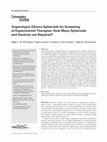
Cytometry Part A, 2009
Cancer spheroids are a valuable model for screening anticancer strategies. However, studies are p... more Cancer spheroids are a valuable model for screening anticancer strategies. However, studies are published using various numbers of spheroids and sections per spheroid. Here, we establish the sample size requirements for valid screening strategies to treat glioma: how many spheroids per experimental group and how many sections per spheroid are required to detect one-third reduction in an endpoint measurement after treatment? From two glioblastoma patients, 32 untreated organotypic spheroids were cultured and sectioned entirely (14–100 sections per spheroid). The viable fraction was determined as endpoint by automated image analysis in sections and used to establish the minimally-detectable difference between a treatment and reference group. Variance was considerable with a coefficient of variance of 21%. The biological variation in viability in sections of spheroids produced 97% of variance when sample size was large. Variance increased when numbers of spheroids but not numbers of sections per spheroid were reduced. A minimum of 12 spheroids per group and one section per spheroid was required for a valid comparison of a treatment group and a control group. When 10 treatment groups and one control group were compared, 16 spheroids per group were required. Thus, the statistical power depended almost entirely on the number of organotypic glioma spheroids and hardly on the number of sections per spheroid. The organotypic glioma spheroid model does not appear to be suitable for high-throughput screening of anticancer strategies, because of the relatively large number of spheroids required. It is the model of choice for low-throughput screening, because this model is far more representative for the parental tumor than any other more efficient glioma model. © 2009 International Society for Advancement of Cytometry
Microscopy Research and Technique, 2006
Reproducibility of cryostat section thickness is required for valid quantitative microscopy. This... more Reproducibility of cryostat section thickness is required for valid quantitative microscopy. This is generally pursued by motorized sectioning using a low but constant speed. The purpose of our study was to compare variation in section thickness between motorized and manual cryostat sectioning. Serial sections were cut from a frozen block of homogenized tissue on different days. Lactate dehydrogenase activity was histochemically detected and calibrated absorbance measurements were taken. The coefficients of variation of measurements was 9.7% for motorized sectioning and 3.3% for manual sectioning. In conclusion, section thickness is similarly reproducible after manual sectioning compared with motorized sectioning, if not better. Microsc. Res. Tech., 2006. © 2006 Wiley-Liss, Inc.
Cancer Cell, 2010
Kinases execute pivotal cellular functions and are therefore widely investigated as potential tar... more Kinases execute pivotal cellular functions and are therefore widely investigated as potential targets in anticancer treatment. Here we analyze the kinase gene expression profiles of various tumor types and reveal the wee1 kinase to be overexpressed in glioblastomas. We demonstrate that WEE1 is a major regulator of the G 2 checkpoint in glioblastoma cells. Inhibition of WEE1 by siRNA or small molecular compound in cells exposed to DNA damaging agents results in abrogation of the G 2 arrest, premature termination of DNA repair, and cell death. Importantly, we show that the small-molecule inhibitor of WEE1 sensitizes glioblastoma to ionizing radiation in vivo. Our results suggest that inhibition of WEE1 kinase holds potential as a therapeutic approach in treatment of glioblastoma.
Surgery for infiltrative gliomas aims to balance tumor removal with preservation of functional in... more Surgery for infiltrative gliomas aims to balance tumor removal with preservation of functional integrity. The usefulness of intraoperative stimulation mapping (ISM) has not been addressed in randomized trials. This study addresses glioma surgery outcome on the basis of a meta-analysis of observational studies.





Uploads
Papers by Philip de Witt Hamer